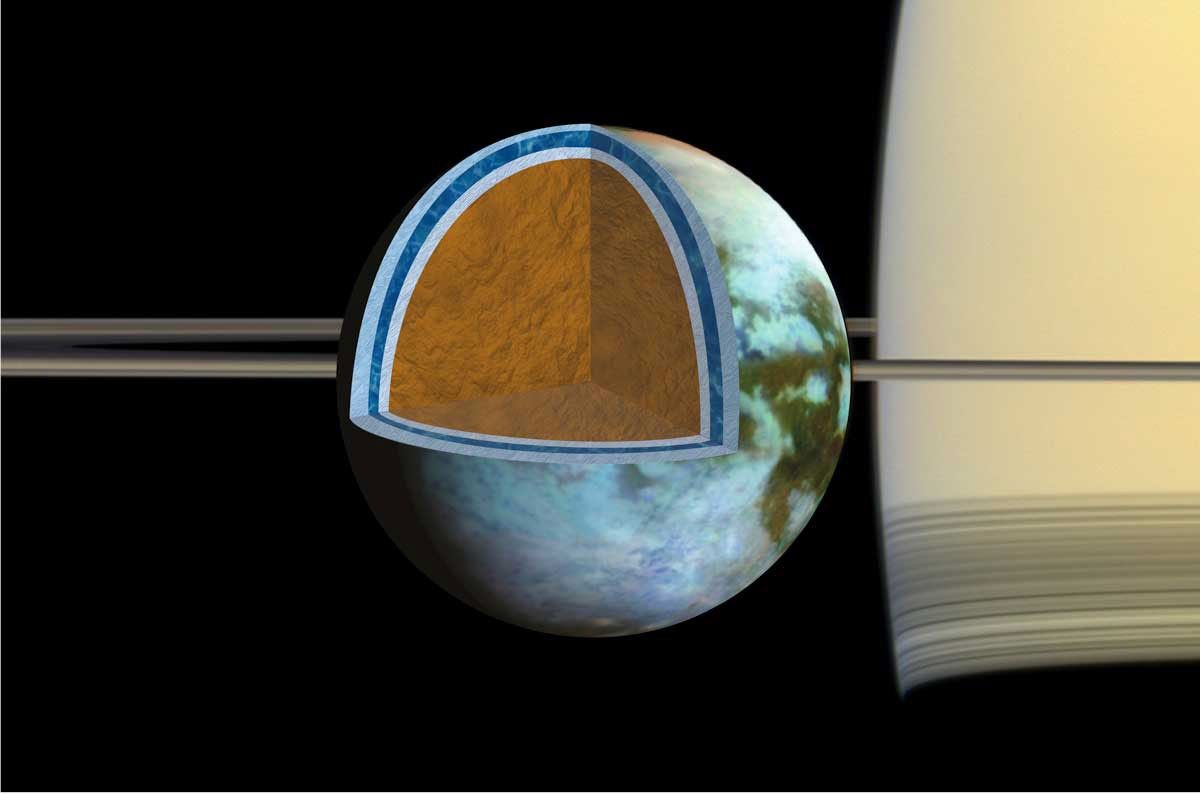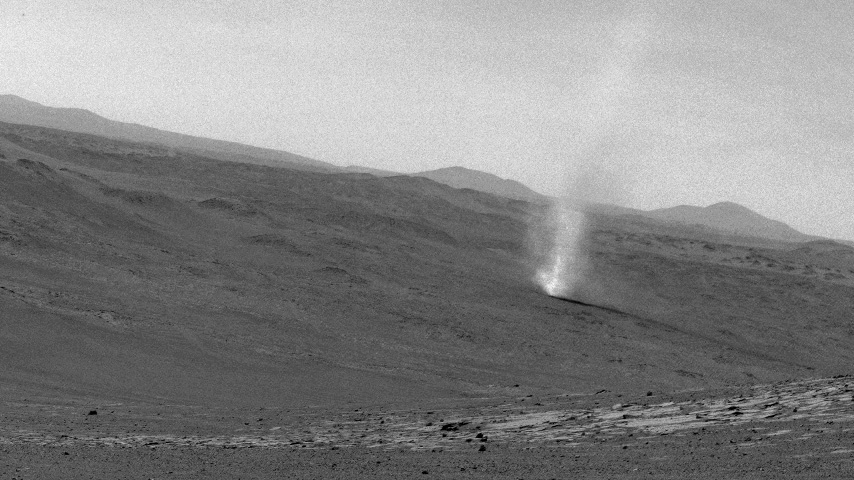2014 was another amazing year of scientific discoveries for the Cassini mission. After commemorating a decade of exploration of Saturn, its rings and its moons, the team looks forward to the science yet to come from the steadfast spacecraft. This list is the Cassini team’s top picks for the mission’s 10 most interesting science findings of 2014.
1.Ocean Detected Inside Enceladus
- NASA's Cassini spacecraft and Deep Space Network provided the first geophysical measurements of the internal structure of Enceladus, consistent with the existence of a hidden ocean inside the moon.
- Gravity measurements suggest a large, possibly regional, ocean about 6 miles (10 kilometers) deep, beneath an ice shell about 19 to 25 miles (30 to 40 kilometers) thick.
- Flyby data yielded evidence of a zone inside the southern end of the moon with higher density than other portions of the interior.
- Surface fractures, known as “tiger stripes,” may lead down to a part of the moon that is tidally heated by the moon's repeated flexing as Enceladus follows its eccentric orbit around Saturn.
Also see:
NASA Space Assets Detect Ocean inside Saturn Moon
2. 101 Geysers Identified on Enceladus
- Scientists have identified 101 distinct geysers erupting on Saturn’s icy moon Enceladus. Their analysis suggests that it is possible for liquid water from the moon's underground sea to reach all the way to its surface.
- Each geyser erupts from one of the tiger stripe fractures and is coincident with small hot spots.
- The greatest geyser activity coincides with the greatest thermal radiation. Comparisons between the geysers and tidal stresses reveal similar connections.
- Opening and closing of the fractures allow water vapor from below to reach the surface.
- Condensation on the surface produces the hot spots.
Also see:
Cassini Spacecraft Reveals 101 Geysers and More on Icy Saturn Moon
3. Possible Birth of a Saturn Moon
- Cassini has documented the formation of a small icy object within the rings of Saturn that may be a new moon, and may also provide clues to the formation of the planet's known moons.
- Disturbances at the very edge of Saturn's A ring – the outermost of the planet's large, bright rings – are about 20 percent brighter than their surroundings, measuring 750 miles (1,200 kilometers) long and 6 miles (10 kilometers) wide, the feature may be caused by the gravitational effects of a nearby object.
- Not expected to grow any larger (and maybe even be falling apart) the formation and outward movement of the object aids in our understanding of how Saturn’s icy moons may have formed in more massive rings long ago. It also provides insight into how Earth and other planets in our solar system may have formed and migrated away from the sun.
- The object, informally named Peggy, is too small to be seen in images so far, but is probably no more than about a half mile (about a kilometer) in diameter.
Also see:
NASA Cassini Images May Reveal Birth of a Saturn Moon
4. Sunny Seas and Clouds Spotted on Titan
- Cassini has captured, for the first time, simultaneous views of both the polar hydrocarbon seas and the sun glinting off one of the seas.
- A bright margin around Kraken Mare – the sea containing the reflected sunglint – indicates that the sea was larger at some point, but evaporation has decreased its size.
- Since a huge storm swept across the icy moon's low latitudes in late 2010, only a few small clouds have been observed anywhere on the icy moon. The lack of cloud activity has surprised researchers.
- Recent images of clouds moving across the northern hydrocarbon seas of Saturn's moon Titan have been obtained. This renewed weather activity, considered overdue by researchers, could finally signal the onset of summer storms that atmospheric models have long predicted.
Also see:
Cassini Sees Sunny Seas on Titan
Cassini Tracks Clouds Developing Over a Titan Sea
5. Hyperion’s Electrostatically Charged Surface
- During a 2005 flyby of Saturn’s moon Hyperion, the spacecraft was briefly bathed in a beam of electrons coming from the moon's electrostatically charged surface.
- Static electricity is known to play an important role on our own dusty moon, but evidence of static charge building up on other objects in the solar system has been elusive until now.
- Hyperion is porous and icy, with a bizarre, sponge-like appearance. Its surface is continuously bombarded by ultraviolet light from the sun and exposed to a rain of electrons and ions within the invisible bubble generated by Saturn’s magnetic field. Researchers think Hyperion's exposure to this hostile space environment is the source of the particle beam that struck Cassini.
- Surface features observed on the asteroid Eros and several of Saturn’s moons might be due to the motion of charged dust across their surfaces.
Also see:
Cassini Caught in Hyperion's Particle Beam
6. “Magic Island” Evolves in Titan Sea
- A mysterious feature, dubbed the “Magic Island” has been monitored in one of Titan’s large hydrocarbon seas. The feature covers an area of about 100 square miles (260 square kilometers) in Ligeia Mare.
- The feature, which appears bright in radar images against the dark background of the liquid sea, was first spotted during Cassini’s July 2013 Titan flyby. It has now been observed twice by Cassini’s radar experiment, but its appearance changed between the two apparitions.
- The feature could be surface waves, rising bubbles, floating solids, solids suspended just below the surface, or perhaps something more exotic.
Also see:
Cassini Watches Mysterious Feature Evolve in Titan Sea
7. Mimas Hides Frozen Core or Ocean
- Even though Mimas’ heavily cratered outward appearance does not suggest anything unusual lies beneath its surface, its interior either has a frozen core shaped something like a football or the satellite contains a liquid water ocean.
- Observations of how much the moon wobbles as it orbits Saturn constrain models for how its interior might be arranged leading to two possibilities that fit the data.
- If Mimas is hiding a liquid water ocean, it lies 15 to 20 miles (24 to 31 kilometers) beneath the moon's impact-battered surface. At 246 miles (396 kilometers) wide, Mimas is too small to have retained internal heat from its formation, so some other source of energy would be required to maintain an underground ocean.
Also see:
Saturn Moon May Hide a “Fossil” Core or an Ocean
8. Bright Clumps Diminish in the F Ring
- The number of exceptionally bright clumps of material in the F ring plummeted during the time between NASA’s Voyager mission and Cassini’s mission, a period of 30 years.
- The diminishing number of bright clumps could be the result of a drop in the number of little moonlets between the Voyager and Cassini eras.
- Saturn’s moon Prometheus is the prime suspect for this behavior. Prometheus orbits just inside the F ring and stirs up the ring particles, sometimes leading to the creation of moonlets, and sometimes leading to their destruction.
- Every 17 years, the orbit of Prometheus aligns with the orbit of the F ring in such a way that its influence is particularly strong spurring the creation of many new moonlets. The moonlets would then crash repeatedly through the F ring, eventually destroying them.
Also see:
Bright Clumps in Saturn Ring Now Mysteriously Scarce
9. Titan’s Salty Sea
- Cassini gravity data has provided firm evidence that the ocean inside Titan might be as salty as Earth’s Dead Sea.
- Findings support previous indications that the moon’s icy shell is rigid and in the process of freezing solid. The thickness of the ice crust varies slightly from place to place, consistent with the ocean slowly crystalizing and turning to ice.
- The ocean is probably an extremely salty brine of water mixed with dissolved salts likely composed of sulfur, sodium and potassium. The density indicated for this brine would give the ocean a salt content roughly equal to the saltiest bodies of water on Earth.
- Outgassing of methane into Titan’s atmosphere must happen at scattered “hot spots” as opposed to via convection or plate tectonics recycling of its ice shell.
Also see:
Ocean on Saturn Moon Could be as Salty as the Dead Sea
10. New Views of Saturn’s Auroras
- Observations from multiple vantage points (e.g. Cassini orbiting Saturn and Hubble orbiting Earth) provided details on how the auroras move, showing the complexity of these auroras and how they connect to outbursts from the sun and their effect on Saturn’s magnetic environment.
- One way that bright auroral storms may be produced is by the formation of new connections between magnetic field lines causing storms within Saturn’s magnetic bubble.
- Mimas and Enceladus can influence Saturn’s light show as well.
- Curtain-like auroras at Saturn, similar to those seen on Earth, are red at the bottom and purple at the top because they are dominated by emission from excited hydrogen molecules.
Also see:
NASA Spacecraft Get a 360-Degree View of Saturn’s Auroras













































